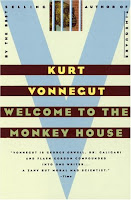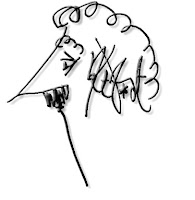 The story at the heart of Petropolis begins in Siberia shortly after the end of the Soviet Union. This book has a lot to do with post-Soviet life, Russian immigrants in America, and the stereotypes that go along with all of that. I notice that on Amazon, many of the whopping nineteen people who have reviewed this book mention how well Anya Ulinich captures the feelings of a Russian immigrant in America. The fact that there are untranslated Russian words and some "in" jokes and references throughout the book tells me that perhaps Ulinich meant for her audience to have Russian ancestry, but my all-American self still enjoyed it.
The story at the heart of Petropolis begins in Siberia shortly after the end of the Soviet Union. This book has a lot to do with post-Soviet life, Russian immigrants in America, and the stereotypes that go along with all of that. I notice that on Amazon, many of the whopping nineteen people who have reviewed this book mention how well Anya Ulinich captures the feelings of a Russian immigrant in America. The fact that there are untranslated Russian words and some "in" jokes and references throughout the book tells me that perhaps Ulinich meant for her audience to have Russian ancestry, but my all-American self still enjoyed it.The book is about a young promising artist, Sasha, who is of mixed Russian-Jewish-African heritage. She's dark-skinned with wiry hair, which makes it impossible for her to fit in with her pale classmates in frigid Siberia. Normalcy is even harder for Sasha to achieve thanks to her neurotic mother and absent father (who emigrated to America without his wife and child). As Sasha becomes a teenager, she makes some poor decisions, and her mother sends her away to an art school in Moscow. Sasha is completely unhappy there, and she holds on to a gnawing need to find her father in America. Still a teenager, she sees an advertisement for a mail-order bride company, and soon, she's in the good ol' U.S. of A.
Once she gets to America, Sasha's life becomes even harder. She's not only looking for her father, but also the happiness that she thought would come with life in America. The book takes you through all the stops along Sasha's journey to happiness, but I had a bit of a hard time sympathizing with her sometimes. Even when things were looking up, she seems to always find a way to be miserable about something. Sasha (and so, obviously, the author as well) realizes this about herself. A lot of the characters in the book are this way. I can't think of a single couple in the book that actually liked each other. They all seemed to just co-exist until they absolutely couldn't stand it anymore. It bothered me as I was reading it, but now that I'm looking back on it, I think that was part of the bigger picture of the book -- the way people just "settle" for things instead of finding what makes them truly happy.
Hmm. Heavy.
It's a good book, and Ulunich is a talented young author. This is her first book, and I would be interested to see if she continues to write about Russian/Soviet characters or takes a new path.
Read from June 25, 2010 to June 28, 2010
3/5 stars
--C












